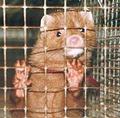 身穿皮草的瑪丹娜名列第9屆年度最糟穿著排行榜第一名,該名單剛由美國人道對待動物協會(People for the Ethical Treatment of Animals,PETA)公布。名單上的名人由造訪PETA網站的網友票選而出,其中包括協會成員和一般民眾,投票期間為2月9日至3月4日。
身穿皮草的瑪丹娜名列第9屆年度最糟穿著排行榜第一名,該名單剛由美國人道對待動物協會(People for the Ethical Treatment of Animals,PETA)公布。名單上的名人由造訪PETA網站的網友票選而出,其中包括協會成員和一般民眾,投票期間為2月9日至3月4日。
雖然PETA未透露精確調查數字,美國人道對待動物協會發言人麥格羅(Michael McGraw)說該名單由數千人投票決定。同樣入選該排行榜的名人包括是雙胞胎瑪莉‧凱特和艾許利‧奧爾森(Mary-Kate and Ashley Olsen)、瑪姬‧賈倫荷(Maggie Gyllenhaal)、伊莉莎白‧赫莉(Elizabeth Hurley),肯伊‧威斯特(Kanye West )則是前5名中唯一穿皮草的男人。
與其他人相比,瑪丹娜獲得多出3倍的選票,PETA發言人麥格勞表示,瑪丹娜在日常生活中,就像她在電影「艾維塔」一樣,經常穿著皮草。
在美國人道對待動物協會隨著調查資料公開的照片中,瑪丹娜穿著一件看起來是由黑疣猴毛皮做成的老式皮草。根據老式時裝同業公會(Vintage Fashion Guild),「猴子毛皮在19世紀中期相當受到歡迎,但自1940年代以降,猴子數目降到令人怵目驚心的數字。」
在世界自然保育聯盟《瀕危物種紅皮書》(Red List of Threatened Species)中,西非原產的黑疣猴列為易瀕臨絕種的物種。麥格羅說,PETA開始出版年度最糟穿著排行榜來揭露少數基於自私心態穿著皮草的名人。
「這些名人受到崇拜,而他們所代表的風格往往引發追隨者的爭相仿傚,因此他們有責任不穿讓動物遭受極大痛苦的產品,」他說。美國皮草資訊委員會(The Fur Information Council of America)就利用名人喜好來販售皮草。「名人是影響時裝的主流,不只提供典範讓消費者模仿,也影響設計師設計的服裝。」該委員會在官方網站上說。
根據國際皮草貿易聯盟(International Fur Trade Federation), 85%皮草工業來自毛皮工廠的動物,而非打獵或者在野外用陷阱捕捉。自2006年12月起,該聯盟使用國際標籤計畫,「讓消費者相信皮草的來源」。來源保證標籤(Origin Assured Label)將告知消費者「毛皮或者皮草產品來自於擁有並有效執行皮草生產相關法規的國家。」
隨著由聯盟成員,如美國皮草資訊委員會所使用的口號「皮草?自然且負責任的選擇」,該產業試圖消除穿皮草的罪惡感。美國人道對待動物協會的數字顯示全球73%的皮草養殖場在歐洲, 12%在北美,其餘則在阿根廷、俄羅斯,特別是中國。
 「中國沒有任何一條動物保護法。美國有確切的動物保護,只不過未徹底實施。在中國,動物遭受拖地、撞擊和活剝。」麥格羅說。來自這些動物的皮草是如此的便宜,以致於它們變成廉價商店中的夾克裝飾和手套。而消費者在購買這些服飾時,絲毫沒有意識到它們來自動物身上,麥格羅說。
「中國沒有任何一條動物保護法。美國有確切的動物保護,只不過未徹底實施。在中國,動物遭受拖地、撞擊和活剝。」麥格羅說。來自這些動物的皮草是如此的便宜,以致於它們變成廉價商店中的夾克裝飾和手套。而消費者在購買這些服飾時,絲毫沒有意識到它們來自動物身上,麥格羅說。
美國人道對待動物協會補充說,中國提供超過一半的美國皮草成衣進口量。該反皮草組織引用來自中國皮草養殖場的第一個祕密調查的資料,該調查已製作成錄影帶、照片,和其他資料。報告的作者林哈德(Heinz Lienhard)解釋錄影帶和照片來自匿名的亞洲調查人員,如果他們的身分曝光將招致生命危險。
「在這些養殖場中,狐狸、貂、兔子,和其他動物在戶外的鐵籠中踏步和顫抖,暴露在大雨、寒夜,或炙熱的太陽下。動物母體則因粗暴的對待和長期禁閉而發瘋,分娩時也無處可躲, 常在生產後殺死其嬰兒。疾病和受傷是常見的,受憂慮引發精神病的動物常咬自己的四肢,並且反覆衝撞籠子。」他們的報告陳述。
「皮草貿易的全球化已使人們無從追查皮草的來源。即使某件皮草的標籤說明產自歐洲某國,動物本身在別處豢養與屠殺 - 也許在一個未受管理的中國皮草養殖場。」美國人道對待動物協會說。
Wrapped in fur, Madonna tops the 9th annual Worst-Dressed List just published by the nonprofit People for the Ethical Treatment of Animals.
The celebrities on the list were selected by visitors to the PETA website, both members and others, whose votes were registered from February 9 through March 4.
While the organization does not give out exact survey figures, PETA spokesman Michael McGraw says "thousands" of people voted.
Also voted to the top of the list are twins Mary-Kate and Ashley Olsen, Maggie Gyllenhaal, Elizabeth Hurley and Kanye West, the only man in the top five group of fur-wearing celebrities.
Madonna received more than three times more votes than any other person, McGraw said. Madonna has often been seen dressed in fur in films like Evita and in everyday life.
In the photo of Madonna PETA published with the survey results, Madonna is wearing what appears to be a vintage garment made of black colobus monkey fur.
According to the Vintage Fashion Guild, "Monkey fur was very popular from the mid-nineteenth century through the 1940's during which time the Colobus Monkey population dropped to alarmingly low numbers."
Native to West Africa, the black colobus monkey is now listed as Vulnerable to extinction on the IUCN Red List of Threatened Species.
McGraw says PETA started published an annual Worst Dressed List "to spotlight the relatively small number of celebrities who for their own selfish reasons wear fur."
"These days celebrities are so revered and oftentimes their style is emulated by their fans, so they have a responsibilty not to wear products of extreme animal suffering," he said.
The Fur Information Council of America, an industry group, uses the preferences of celebrities to sell fur products. "Celebrities are a major influence on fashion, not just as role models for consumers to emulate, but also on the garments being produced by designers," the council says on its website.
According to the International Fur Trade Federation, 85 percent of the fur industry's skins come from animals in fur factory farms, rather than animals hunted or trapped in the wild.
Since December 2006, the federation has used an international labeling program that "gives consumers confidence about the provenance of the fur they are buying." The Origin Assured Label (OA? informs consumers that "the fur or fur product comes from a country where national or local regulations or standards governing fur production are in force."
With slogans such as "Fur ?the natural, responsible choice," used by federation members such as the Fur Information Council of America, the industry is attempting to remove the stigma of wearing fur.
PETA figures show that 73 percent of the world's fur farms are in Europe, 12 percent are in North America, and the rest are in countries such as Argentina, Russia and particularly in China.
China has not a single animal protection law , "We have certain protection for animals in the United States, but they are just not enforced. In China, animals are smashed into the ground and skinned alive while fully conscious."
Fur from these animals is so cheap that it winds up as trim on jackets and gloves in discount stores at prices so low that consumers buy these garments without realizing that that they are from real animals, says McGraw.
PETA says China supplies more than half the finished fur garments imported for sale in the United States. The anti-fur organization cites the first undercover investigation of fur farms in China, which produced a video, photos and other documents.
The report's author Heinz Lienhard explains that the video and photos were obtained by Asian investigators who must remain anonymous because their lives would be in danger if their identities were known.
"On these farms, foxes, minks, rabbits, and other animals pace and shiver in outdoor wire cages, exposed to driving rain, freezing nights, and, at other times, scorching sun," their report states. "Mother animals, who are driven crazy from rough handling and intense confinement and have nowhere to hide while giving birth, often kill their babies after delivering litters. Disease and injuries are widespread, and animals suffering from anxiety-induced psychosis chew on their own limbs and throw themselves repeatedly against the cage bars."
Globalization of the fur trade has made it impossible to know where fur products come from," PETA says. "Even if a fur garment's label says it was made in a European country, the animals were likely raised and slaughtered elsewhere - possibly on an unregulated Chinese fur farm."




